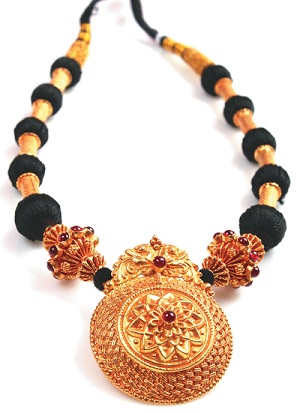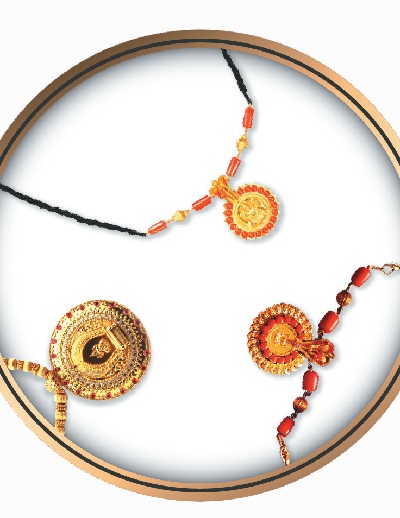A mark of an everlasting bond, tying the Mangalsutra has been an auspicious tradition followed in most marriages for centuries in India. Originally a Hindu tradition, the mangalsutra has become such a universal symbol in Indian weddings that over time, other religions have also adopted the tradition of tying the mangalsutra. Mostly made in gold, the meaning and history behind the mangalsutra is profound, and has different cultural implications in different parts of India. While in some parts of India, people still uphold the traditional way of adorning the propitious piece of jewellery, in some parts, people have acclimatized to new and modern designs of wearing the mangalsutra. By Vijetha Rangabashyam.

The Hindu scriptures don’t speak much of the mangalsutra, which literally means “sacred threadâ€. In fact, there has not been any reference of such a tradition where the husband ties this auspicious thread to the wife’s neck in any of the Hindu epics where Swayamwara was the way of marrying. So why is it such an integral part of wedding ceremonies then? It is a custom that has been adopted by the people for many years now and its association with longevity and prosperity of both the marriage and the people involved has given it such a reverence. While it is called mangalsutra in the North, it is called Thaali, Thirumangalyam and Minnu in South India. In fact, it is believed that the tradition initially was exclusive to the South and then it gradually moved to the North.
The origin of the mangalsutra tying tradition seems a little unclear but the legend has it that initially it was associated to thread tied to a child’s wrist for protection and warding off evil. Later on, some poems indicate that men used to hunt and fight tigers bravely and bring its tooth to their respective women. The women in turn would tie the tiger’s tooth to a thread and wear it around their neck as a token of love and a tiger’s tooth was considered very auspicious in the olden days. This tradition could have paved way for what is today called the mangalsutra.
Today, the mangalsutra is worn in many forms and designs depending on the region, religion, caste and even subcaste. While in some parts of the south, a gold pendant is tied to a thread stained in turmeric, in some parts of the south and the north, black beads are strung together as a chain and are worn as mangalsutra. As time went on, the mangalsutra has shape-shifted into varied forms to suit the convenience of the wearer and today, depending on the affordability of a family, mangalsutras studded with diamonds and other semiprecious stones are also widely popular.
North, West & the East
India is known for its diversity, so a tradition such as the mangalsutra though may represent a universal sentiment, the practices that surround it are vastly different in the north to that of the south. In Kashmir, the Mangalsutra worn by women is called Dejhoor. Made out of pure gold, the dejhoor is hexagonal in shape and Aath the chain that holds the dejhoor is worn around the ears, a tradition unlike none. The shape of the dejhoor is a symbol of the oneness of Lord Shiva and Goddess Parvati with a dot in the middle that connotes stability. Initially, the dejhoor is tied to a red thread on the day of the wedding and it is tied to the aath later on. Kashmiri women wear it as an ornament to functions and auspicious ceremonies these days.

Further down, in Delhi and other parts of North India, black beaded chain is attached to what is known as Tanmaniya, a gold pendant. The Punjabis and other North Indians consider these black beads interspersed with gold string as their mangalsutra. Though similar to the North Indian mangalsutra, the Gujaratis now-a-days wear diamond studded ones – once the wedding ceremony is over, the mangalsutra also acts as a piece of ornament. Traditionally, mangalsutra as a concept was absent in the Marwari tradition but later on, the community adopted the custom as their own. It is interesting to note that the Bengalis and Oriyas don’t have mangalsutra as part of their rituals What is interesting is that in some cultures in the North and in Rajasthan, Bengal and Orissa, the chuda (bangles) carry more importance.
The Maharashtrians however give utmost importance to the mangalsutra. Two bowl-shaped gold pendants known as vatis are attached on either side and are strung to a black-beaded chain. The black-beaded chain represents Shiva and Parvati while the gold pendant bearing the vatis is symbolic of the holy union of marriage. Maharashtrians believe the black beads have the ability to ward off the evil and also aid in the stability of the marriage. A chain with just the black beads is called as nirgun while those separated with gold beads are called shagun.

The South
There is no wedding ceremony devoid of the mangalsutra in the south commonly referred to as the Thaali in Tamil Nadu and Kerala, Mangalya Sutra in Karnataka and Mangalasutramu in Andhra Pradesh. The Kannadiga mangalsutra of Karnataka bears similarity to the Maharashtrian one, except that the vatis (bowls) are usually flat. The vatis are ideally strung with coral beads, pearls and other gemstones depending on the bride or the family’s preference. The Coorgi women however adorn something called the Karthamani Pathak which they consider as the Mangalsutra. Karthamani (black beads) is attached to the pathak (pendant) which is usually a gold coin with goddess Lakshmi or Queen Victoria embossed on it. The small cobra atop the pendant represents fertility. The Coorgi mangalsutra has corals and gold beads strung together along with the black beads. Mangalsutra in Andhra is also called as putselu or bottu in telugu and again has two discs (coins) made of gold which is then separated by coral beads.
Kerala Hindus refer to the mangalsutra as Thaali while the Christians call it ‘Minnu’. Generally, the Muslims from Kerala don’t have the custom of tying the mangalsutra with the exception of South Kerala Muslims from Travancore. The Nairs and the Menons wear what is called as the ‘ela thaali’ (leaf mangalsutra). A small banyan leaf is attached to a gold chain; the leaf represents the banyan tree, a symbol of shelter, protection and care. The Minnu worn by the Kerala Christians is usually a heart-shaped pendant that bears the Cross. The heart represents love and affection while the Cross is the religious symbol of Christianity that stands for the relationship between Jesus and his bride, the Church.

The Tamils almost have 30 different kinds of thaalis. Unlike north India and even some parts of the south, the Tamil thaali differs based on castes and sub-castes of the families. The thaali refers to the pendant that is usually made in gold. It is then attached to a yellow thread known as the manja kayiru (yellow thread). The thaali bears different symbols like the goddess Meenakshi (Parvati), Shiv Ling or the Tulsi plant all a Tamil Gounder Mangalsutra Andhra-style Mangalsutra representation of fertility. The Iyers, part of the Tamil Brahmin community usually adorn an ‘M’ shaped pendant which bears the symbols of Shiv Ling and Parvati while the Iyengars wear a smiliar ‘M’ shaped pendant with symbols of Naman (one that is found on Lord Vishnu’s forehead), conch and chakra (found on Vishnu’s hands). The thaali (pendants) weigh between 4 to 8 grams in either 18 kt or 22 kt gold. After the wedding
ceremony, the young bride attaches the thaali to a gold chain of her choice.
The most unique and exclusive kind of mangalsutras were worn by the Naatukottai Chettiar community of Tamil Nadu. Known for their affluence and wealth, the mangalsutras, some weighing even as heavy as hundred sovereigns, are made by the maternal grandparents of the girl while she is still young. The heavy piece of mangalsutra is usually commissioned to the family jeweller and is created in such a way that it is both decorative and symbolic. Today, brides wear a smaller/practical mangalsutra but the heavy, exclusive Chettiar thaali is worn during special occasions.
Be the first to comment